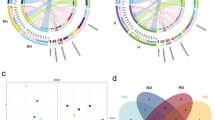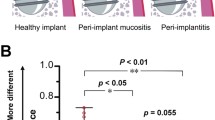Abstract
The long-term success of osseointegrated oral implants is endangered by inflammation of peri-implant hard and soft tissues caused by bacterial biofilms that may have been initiated by bacterial transmission from the adjacent dentition. The present study aimed to compare the bacterial communities at inflamed implant and tooth sites by broad-range PCR techniques to evaluate the etiological processes of peri-implant and periodontal diseases and potential future therapeutic strategies. Eighteen samples of peri-implant and periodontal microflora were collected from nine partially edentulous patients with implant-retained crowns or bridges revealing clinical signs of gingivitis or mucositis. The clinical parameters plaque index (PI), probing depth (PD), and bleeding on probing were recorded. Amplified fragments of bacterial 16S rRNA genes were separated by use of single-strand conformation polymorphism analysis, and sequences were determined to identify the predominant bacterial genera. The clinical parameters PI and PD were significantly different at implants (PI = 0.4 ± 0.7, PD = 3.1 ± 0.6 mm) compared with teeth (PI = 1.8 ± 0.8, PD = 2.5 ± 0.2 mm). A total of 20 different genera were found at the inflamed tooth and implant sites. The microbial diversity of the microflora surrounding the remaining dentition (12.0 ± 3.8) was significantly higher (p = 0.01) than the diversity of the peri-implant microflora at implant-retained crowns or bridges (6.3 ± 2.3). Within the limitations of the present study, the microbial diversity of the investigated implants and teeth with clinical signs of mucositis or gingivitis exhibits substantial differences, demonstrating that transmission of the complete bacterial microflora from teeth to implants could be excluded. Furthermore, broad-range molecular biological detection methods specify bacterial genera and species in the peri-implant and periodontal microflora which were not in the focus of research interests so far.

Similar content being viewed by others
References
Snauwaert K, Duyck J, van Steenberghe D, Quirynen M, Naert I (2000) Time dependent failure rate and marginal bone loss of implant supported prostheses: a 15-year follow-up study. Clin Oral Investig 4(1):13–20
Esposito M, Hirsch JM, Lekholm U, Thomsen P (1998) Biological factors contributing to failures of osseointegrated oral implants. (II). Etiopathogenesis. Eur J Oral Sci 106(3):721–764
Berglundh T, Persson L, Klinge B (2002) A systematic review of the incidence of biological and technical complications in implant dentistry reported in prospective longitudinal studies of at least 5 years. J Clin Periodontol 29(Suppl 3):197–212, discussion 232–193
Heuer W, Elter C, Demling A, Neumann A, Suerbaum S, Hannig M, Heidenblut T, Bach FW, Stiesch-Scholz M (2007) Analysis of early biofilm formation on oral implants in man. J Oral Rehabil 34(5):377–382
Slots J (1977) The predominant cultivable microflora of advanced periodontitis. Scand J Dent Res 85(2):114–121
Loe H, Theilade E, Jensen SB (1965) Experimental gingivitis in man. J Periodontol 36:177–187
Quirynen M, Vogels R (2002) Clinical relevance of surface characteristics on the formation of plaque on teeth and implants. Ned Tijdschr Tandheelkd 109(11):422–429
Slots J (1977) Microflora in the healthy gingival sulcus in man. Scand J Dent Res 85(4):247–254
Hannig M (1997) Transmission electron microscopic study of in vivo pellicle formation on dental restorative materials. Eur J Oral Sci 105(5 Pt 1):422–433
Li J, Helmerhorst EJ, Leone CW, Troxler RF, Yaskell T, Haffajee AD, Socransky SS, Oppenheim FG (2004) Identification of early microbial colonizers in human dental biofilm. J Appl Microbiol 97(6):1311–1318
Aas JA, Paster BJ, Stokes LN, Olsen I, Dewhirst FE (2005) Defining the normal bacterial flora of the oral cavity. J Clin Microbiol 43(11):5721–5732
Leonhardt A, Berglundh T, Ericsson I, Dahlen G (1992) Putative periodontal pathogens on titanium implants and teeth in experimental gingivitis and periodontitis in beagle dogs. Clin Oral Implants Res 3(3):112–119
Berglundh T, Lindhe J, Marinello C, Ericsson I, Liljenberg B (1992) Soft tissue reaction to de novo plaque formation on implants and teeth. An experimental study in the dog. Clin Oral Implants Res 3(1):1–8
Ericsson I, Berglundh T, Marinello C, Liljenberg B, Lindhe J (1992) Long-standing plaque and gingivitis at implants and teeth in the dog. Clin Oral Implants Res 3(3):99–103
Abrahamsson I, Berglundh T, Lindhe J (1998) Soft tissue response to plaque formation at different implant systems. A comparative study in the dog. Clin Oral Implants Res 9(2):73–79
Rozen R, Bachrach G, Steinberg D (2004) Effect of carbohydrates on fructosyltransferase expression and distribution in Streptococcus mutans GS-5 biofilms. Carbohydr Res 339(18):2883–2888
Lima EM, Koo H, Vacca Smith AM, Rosalen PL, Del Bel Cury AA (2008) Adsorption of salivary and serum proteins, and bacterial adherence on titanium and zirconia ceramic surfaces. Clin Oral Implants Res 19(8):780–785
Kreth J, Merritt J, Qi F (2009) Bacterial and host interactions of oral streptococci. DNA Cell Biol 28(8):397–403
Demling A, Demling C, Schwestka-Polly R, Stiesch M, Heuer W (2009) Influence of lingual orthodontic therapy on microbial parameters and periodontal status in adults. Eur J Orthod 31:638–642
Grossner-Schreiber B, Teichmann J, Hannig M, Dorfer C, Wenderoth DF, Ott SJ (2009) Modified implant surfaces show different biofilm compositions under in vivo conditions. Clin Oral Implants Res 20(8):817–826
Gouvoussis J, Sindhusake D, Yeung S (1997) Cross-infection from periodontitis sites to failing implant sites in the same mouth. Int J Oral Maxillofac Implants 12(5):666–673
Brown LJ, Johns BA, Wall TP (2002) The economics of periodontal diseases. Periodontol 2000 29:223–234
Heuer W, Stiesch M, Abraham WR (2011) Microbial diversity of supra- and subgingival biofilms on freshly colonized titanium implant abutments in the human mouth. Eur J Clin Microbiol Infect Dis 30:193–200
Altschul SF, Gish W, Miller W, Myers EW, Lipman DJ (1990) Basic local alignment search tool. J Mol Biol 215(3):403–410
Cole JR, Wang Q, Cardenas E, Fish J, Chai B, Farris RJ, Kulam-Syed-Mohideen AS, McGarrell DM, Marsh T, Garrity GM, Tiedje JM (2009) The Ribosomal Database Project: improved alignments and new tools for rRNA analysis. Nucleic Acids Res 37(Database issue):D141–D145
Seksik P, Rigottier-Gois L, Gramet G, Sutren M, Pochart P, Marteau P, Jian R, Dore J (2003) Alterations of the dominant faecal bacterial groups in patients with Crohn’s disease of the colon. Gut 52(2):237–242
Mombelli A, van Oosten MA, Schurch E Jr, Land NP (1987) The microbiota associated with successful or failing osseointegrated titanium implants. Oral Microbiol Immunol 2(4):145–151
Ong ES, Newman HN, Wilson M, Bulman JS (1992) The occurrence of periodontitis-related microorganisms in relation to titanium implants. J Periodontol 63(3):200–205
Kolenbrander PE (2000) Oral microbial communities: biofilms, interactions, and genetic systems. Annu Rev Microbiol 54:413–437
Salvi GE, Furst MM, Lang NP, Persson GR (2008) One-year bacterial colonization patterns of Staphylococcus aureus and other bacteria at implants and adjacent teeth. Clin Oral Implants Res 19(3):242–248
Mineoka T, Awano S, Rikimaru T, Kurata H, Yoshida A, Ansai T, Takehara T (2008) Site-specific development of periodontal disease is associated with increased levels of Porphyromonas gingivalis, Treponema denticola, and Tannerella forsythia in subgingival plaque. J Periodontol 79(4):670–676
Quirynen M, Vogels R, Peeters W, van Steenberghe D, Naert I, Haffajee A (2006) Dynamics of initial subgingival colonization of ‘pristine’ peri-implant pockets. Clin Oral Implants Res 17(1):25–37
Danser MM, van Winkelhoff AJ, de Graaff J, Loos BG, van der Velden U (1994) Short-term effect of full-mouth extraction on periodontal pathogens colonizing the oral mucous membranes. J Clin Periodontol 21(7):484–489
Lau L, Sanz M, Herrera D, Morillo JM, Martin C, Silva A (2004) Quantitative real-time polymerase chain reaction versus culture: a comparison between two methods for the detection and quantification of Actinobacillus actinomycetemcomitans, Porphyromonas gingivalis and Tannerella forsythensis in subgingival plaque samples. J Clin Periodontol 31(12):1061–1069
Keller W, Bragger U, Mombelli A (1998) Peri-implant microflora of implants with cemented and screw retained suprastructures. Clin Oral Implants Res 9(4):209–217
Lazarevic V, Whiteson K, Hernandez D, Francois P, Schrenzel J (2010) Study of inter- and intra-individual variations in the salivary microbiota. BMC Genomics 11:523
Elter C, Heuer W, Demling A, Hannig M, Heidenblut T, Bach FW, Stiesch-Scholz M (2008) Supra- and subgingival biofilm formation on implant abutments with different surface characteristics. Int J Oral Maxillofac Implants 23(2):327–334
Burgers R, Gerlach T, Hahnel S, Schwarz F, Handel G, Gosau M (2010) In vivo and in vitro biofilm formation on two different titanium implant surfaces. Clin Oral Implants Res 21(2):156–164
Preza D, Olsen I, Willumsen T, Grinde B, Paster BJ (2009) Diversity and site-specificity of the oral microflora in the elderly. Eur J Clin Microbiol Infect Dis 28(9):1033–1040
Lindhe J, Berglundh T, Ericsson I, Liljenberg B, Marinello C (1992) Experimental breakdown of peri-implant and periodontal tissues. A study in the beagle dog. Clin Oral Implants Res 3(1):9–16
Acknowledgments
We are indebted to Ralph Scherer and Dr. Ludwig Hoy from the Institute for Biometry at the Hannover Medical School for the excellent statistical consultancy. This study was supported by the Deutsche Forschungsgemeinschaft (SFB 599 TP D8; PI: M. Stiesch)
Conflict of interest
The authors declare that they have no conflict of interest.
Author information
Authors and Affiliations
Corresponding author
Additional information
Wieland Heuer and Andreas Kettenring contributed equally to the manuscript.
Rights and permissions
About this article
Cite this article
Heuer, W., Kettenring, A., Stumpp, S.N. et al. Metagenomic analysis of the peri-implant and periodontal microflora in patients with clinical signs of gingivitis or mucositis. Clin Oral Invest 16, 843–850 (2012). https://doi.org/10.1007/s00784-011-0561-8
Received:
Accepted:
Published:
Issue Date:
DOI: https://doi.org/10.1007/s00784-011-0561-8




